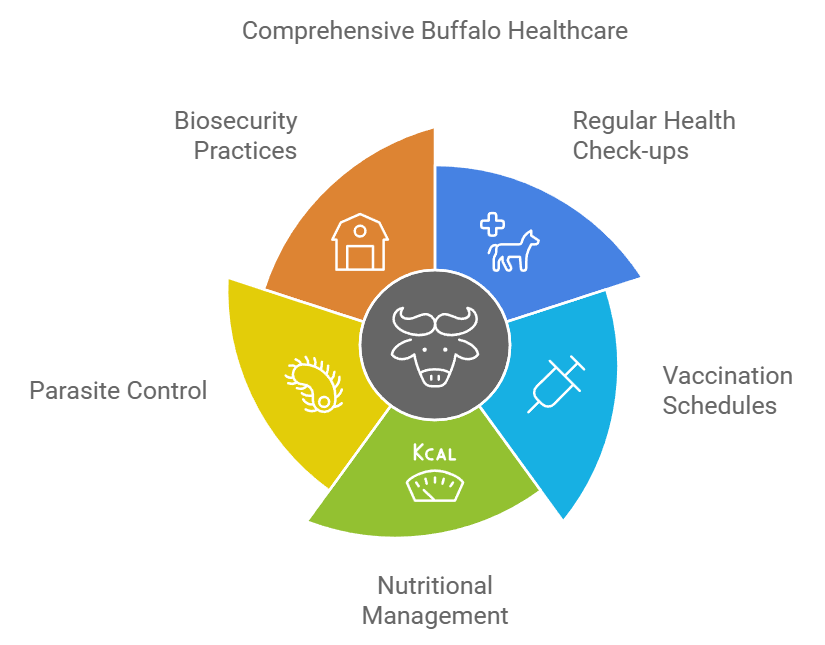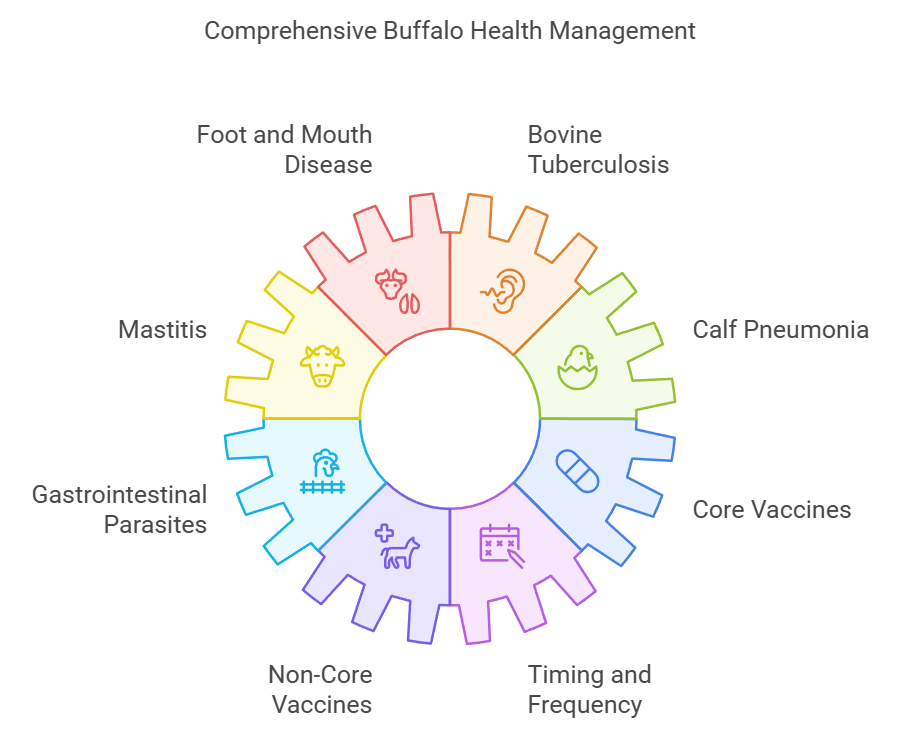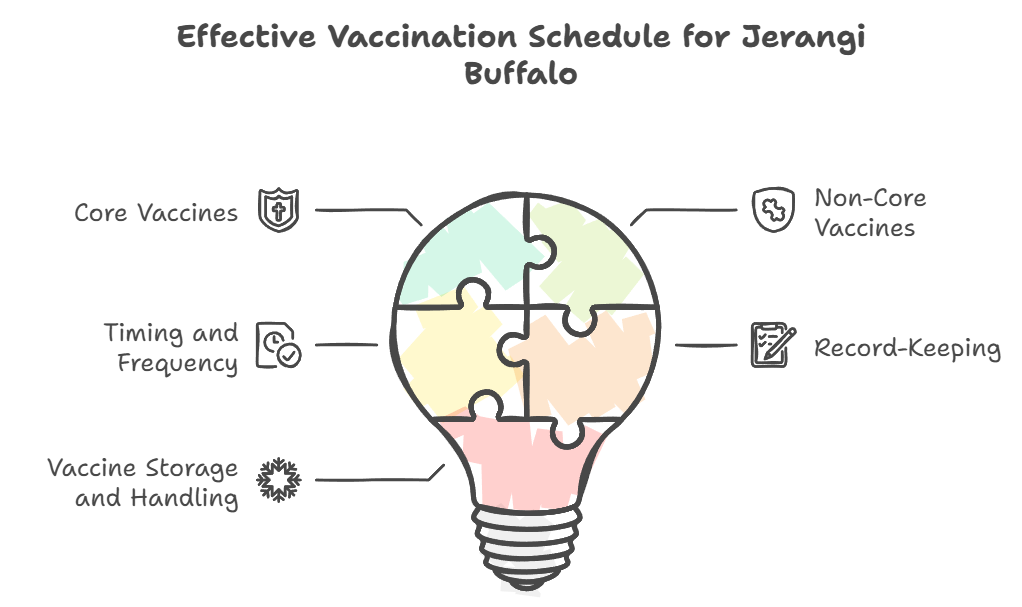Welcome to the ultimate guide on Health and Veterinary Care for Jerangi Buffalo! Did you know that maintaining optimal health in your Jerangi Buffalo can increase milk production by up to 20%?
Whether you’re a seasoned buffalo farmer or just starting out, understanding the nuances of buffalo health is crucial.
In this article, we’ll discuss about the best practices, common health issues, and effective veterinary care strategies to keep your Jerangi Buffalo thriving.
Preventative Veterinary Care for Jerangi Buffalo

Taking care of your Jerangi Buffalo starts with preventative healthcare measures. Trust me, I learned this the hard way when I first noticed some unusual signs in my herd.
Regular health check-ups are a must! Make sure you schedule routine examinations with a qualified veterinarian.
It might seem like an extra expense, but catching issues early can save you a lot in the long run.
Regular Health Check-ups
Don’t skip those vet visits! Regular health check-ups help in early detection of diseases. It’s like going for a yearly physical – essential for long-term health.
Vaccination Schedules
Vaccinations are your buffalo’s best defense against common diseases. Stick to a vaccination schedule to keep your herd safe. I remember when my buffalo got sick with something preventable – it was a wake-up call!
Nutritional Management
A balanced diet is key to preventing malnutrition and related health issues. Ensure your buffalo gets the right mix of grains, greens, and minerals. It’s amazing how much better they perform when well-fed!
Parasite Control
Managing internal and external parasites can be tricky. Regular deworming and using appropriate treatments can keep your buffalo free from these pesky invaders. Trust me, nothing beats the frustration of dealing with parasite infestations.
Biosecurity Practices
Implementing strong biosecurity measures prevents the introduction and spread of diseases. Simple steps like quarantining new animals and maintaining cleanliness can make a huge difference.
Common Diseases Affecting Jerangi Buffalo and Treatment Options

Let’s talk about some of the most prevalent ones and how to tackle them.
Foot and Mouth Disease
This highly contagious disease can spread rapidly among your herd. Look out for symptoms like blisters in the mouth and on the feet. Early treatment and isolation of affected animals are crucial to control the outbreak.
Bovine Tuberculosis
Bovine tuberculosis is a serious illness that can impact both buffalo and humans. Regular testing and maintaining good farm hygiene are essential to prevent transmission. I once had to deal with a case, and it taught me the importance of vigilance.
Mastitis
Mastitis, an infection of the udder, can severely affect milk production. Keep the udders clean and dry, and seek veterinary help at the first sign of infection. It’s heartbreaking to see your buffalo in discomfort, so prompt action is necessary.
Calf Pneumonia
Pneumonia in calves can be life-threatening. Ensure that young buffalo receive adequate nutrition and are kept in a clean, dry environment. Proper ventilation in housing areas can also help prevent respiratory issues.
Gastrointestinal Parasites
These parasites can cause significant health problems. Regular deworming and maintaining pasture hygiene are effective ways to manage them. Don’t let your buffalo suffer from digestive issues – stay on top of parasite control!
Related : 10 Common Goat Diseases Every Farmer Should Know: Prevention and Treatment Guide
Vaccination Schedules Essential for Jerangi Buffalo Well-being

Vaccinations are a cornerstone of Jerangi Buffalo health. Here’s how to create an effective vaccination schedule.
Core Vaccines
Core vaccines are essential for every Jerangi Buffalo. They protect against the most common and dangerous diseases. Make sure your buffalo receive these without fail.
Non-Core Vaccines
Depending on your region, additional vaccines might be necessary. Consult with your veterinarian to determine which non-core vaccines are appropriate for your herd.
Timing and Frequency
Administer vaccines at the right time and frequency. Missing a vaccination can leave your buffalo vulnerable. I remember missing a booster shot once – not a pleasant experience!
Record-Keeping
Keep accurate records of all vaccinations. This helps in tracking your buffalo’s health and ensures no doses are missed. A simple spreadsheet can do wonders!
Vaccine Storage and Handling
Proper storage and handling of vaccines are crucial to maintain their efficacy. Always follow the storage guidelines provided by the manufacturer to ensure your buffalo get the best protection.
Natural Remedies and Supplements for Jerangi Buffalo Health

Sometimes, nature offers the best solutions. Some natural remedies and supplements that can boost your Jerangi Buffalo’s health:
Herbal Supplements
Herbs like neem and tulsi can enhance your buffalo’s immune system. Incorporate these into their diet for added health benefits. It’s incredible how nature can support their well-being!
Probiotics
Probiotics help in maintaining a healthy digestive system. Adding these to their feed can improve nutrient absorption and overall health. My buffalo seemed much more energetic after I started using probiotics.
Essential Oils
Essential oils can be used for parasite control and maintaining skin health. Just a few drops in their environment can make a big difference.
Homeopathic Treatments
Exploring homeopathic treatments can offer alternative solutions for common ailments. It’s worth trying these gentle remedies before opting for more invasive treatments.
Nutritional Supplements
Vitamins and minerals are crucial for a strong immune system. Ensure your buffalo receive the necessary supplements to keep them healthy and productive.
Routine Veterinary Check-ups: What Jerangi Buffalo Farmers Should Know

Regular veterinary check-ups are the backbone of buffalo herd health. Here’s what you need to know to make the most out of these visits.
Scheduling Regular Visits
Plan your vet visits regularly, not just when something is wrong. Preventative care is always better than reactive treatment.
Health Monitoring
Keep an eye on key health indicators like weight, appetite, and behavior. Early detection of issues can save your buffalo from severe health problems.
Emergency Care Preparedness
Be prepared for sudden health issues. Have a plan in place and know the contact details of your trusted veterinarian. It’s better to be safe than sorry!
Collaborating with Veterinarians
Build a strong relationship with your vet. Their expertise is invaluable in maintaining the health of your herd. Don’t hesitate to ask questions or seek advice.
Cost Management
Budgeting for routine and emergency veterinary care is essential. Allocate funds to ensure you can provide the best care without financial stress. It’s all about being prepared!
Final Thought
Maintaining the health and veterinary care of your Jerangi Buffalo is not just about preventing diseases—it’s about fostering a thriving, productive herd that can sustain your farming operations for years to come.
By implementing the preventative measures, understanding common health issues, adhering to vaccination schedules, exploring natural remedies, and ensuring regular veterinary check-ups, you’re setting your buffalo up for success. Ready to take the next step?
Start applying these strategies today and watch your Jerangi Buffalo flourish! Have your own tips or experiences? Share them in the comments below—we’d love to hear from you!




